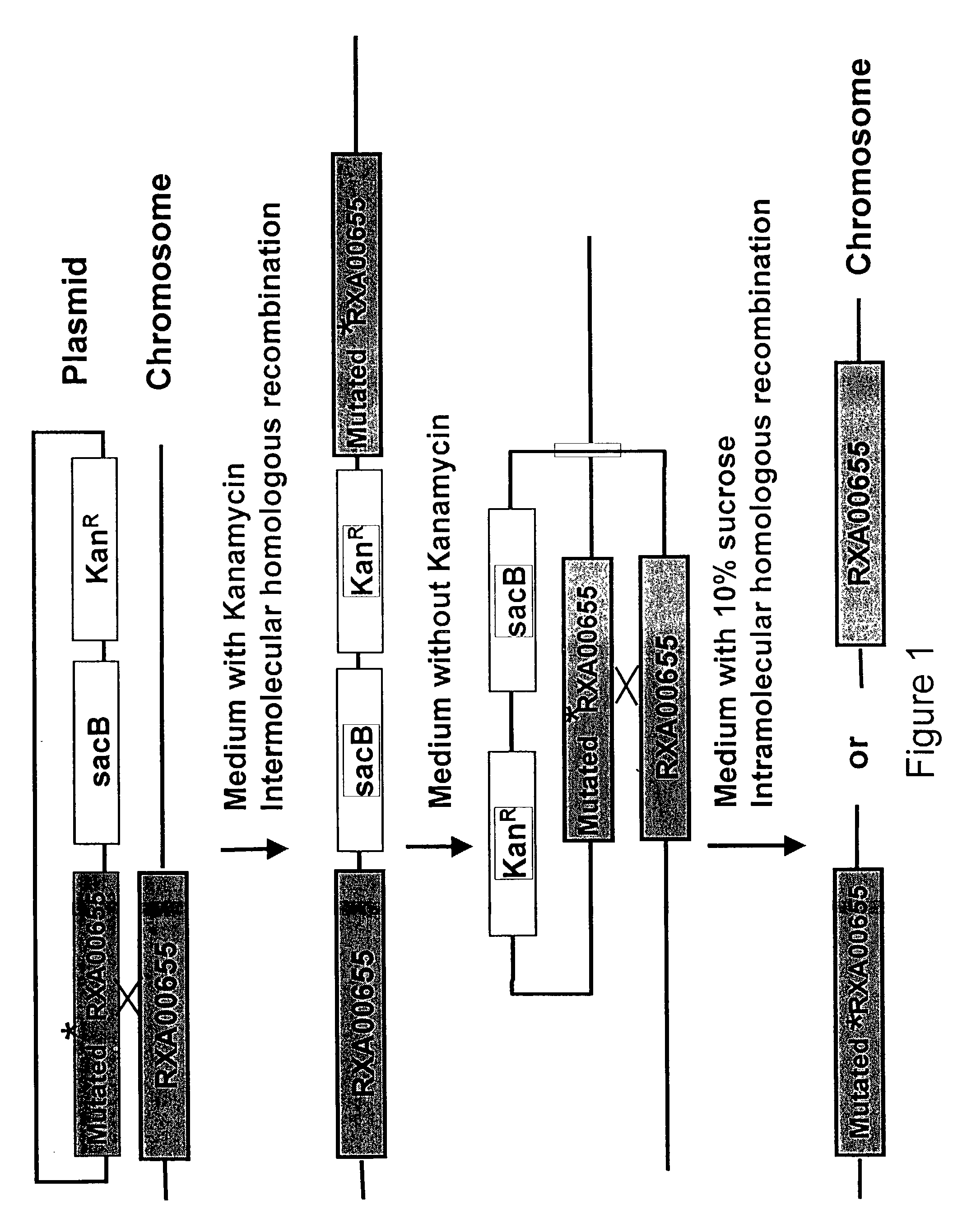Nucleic acid molecules encoding metabolic regulatory proteins from Corynebacterium glutamicum, useful for increasing the production of methionone by a microorganism
a technology of metabolic regulatory proteins and nucleic acids, which is applied in the direction of enzymology, peptides, transferases, etc., can solve the problems of large molar excess of unused salts in the chemical process, low yield of fermentatively produced methionine, and economic and ecological challenges, so as to stimulate mr protein activity or mr nucleic acid expression, the effect of increasing yield
- Summary
- Abstract
- Description
- Claims
- Application Information
AI Technical Summary
Benefits of technology
Problems solved by technology
Method used
Image
Examples
example 1
Preparation of Total Genomic DNA of Corynebacterium Glutamicum ATCC 13032
[0146]A culture of Corynebacterium glutamicum (ATCC 13032) was grown overnight at 30° C. with vigorous shaking in BHI medium (Difco). The cells were harvested by centrifugation, the supernatant was discarded and the cells were resuspended in 5 ml buffer-I (5% of the original volume of the culture—all indicated volumes have been calculated for 100 ml of culture volume). Composition of buffer-I: 140.34 g / l sucrose, 2.46 g / l MgSO4×7H2O, 10 ml / l KH2PO4 solution (100 g / l, adjusted to pH 6.7 with KOH), 50 ml / l M12 concentrate (10 g / l (NH4)2SO4, 1 g / l NaCl, 2 g / l MgSO4×7H2O, 0.2 g / l CaCl2, 0.5 g / l yeast extract (Difco), 10 ml / l trace-elements-mix (200 mg / l FeSO4×H2O, 10 mg / l ZnSO4×7 H2O, 3 mg / l MnCl2×4 H2O, 30 mg / l H3BO3 20 mg / l CoCl2×6 H2O, 1 mg / l NiCl2×6 H2O, 3 mg / l Na2MoO4×2 H2O, 500 mg / l complexing agent (EDTA or critic acid), 100 ml / l vitamins-mix (0.2 mg / l biotin, 0.2 mg / l folic acid, 20 mg / l p-amino benzoic aci...
example 2
Construction of Genomic Libraries in Escherichia Coli of Corynebacterium Glutamicum ATCC13032
[0147]Using DNA prepared as described in Example 1, cosmid and plasmid libraries were constructed according to known and well established methods (see e.g., Sambrook, J. et al. (1989) “Molecular Cloning: A Laboratory Manual”, Cold Spring Harbor Laboratory Press, or Ausubel, F. M. et al. (1994) “Current Protocols in Molecular Biology”, John Wiley & Sons.)
[0148]Any plasmid or cosmid could be used. Of particular use were the plasmids pBR322 (Sutcliffe, J. G. (1979) Proc. Natl. Acad. Sci. USA, 75:3737-3741); pACYC177 (Change & Cohen (1978) J. Bacteriol 134:1141-1156), plasmids of the pBS series (pBSSK+, pBSSK− and others; Stratagene, LaJolla, USA), or cosmids as SuperCos1 (Stratagene, LaJolla, USA) or Lorist6 (Gibson, T. J., Rosenthal A. and Waterson, R. H. (1987) Gene 53:283-286. Gene libraries specifically for use in C. glutamicum may be constructed using plasmid pSL109 (Lee, H.-S. and A. J. S...
example 3
DNA Sequencing and Computational Functional Analysis
[0149]Genomic libraries as described in Example 2 were used for DNA sequencing according to standard methods, in particular by the chain termination method using ABI377 sequencing machines (see e.g., Fleischman, R. D. et al. (1995) “Whole-genome Random Sequencing and Assembly of Haemophilus Influenzae Rd., Science, 269:496-512). Sequencing primers with the following nucleotide sequences were used: 5′-GGAAACAGTATGACCATG-3′ (SEQ ID NO: 24) or 5′-GTAAAACGACGGCCAGT-3′ (SEQ ID NO: 25).
PUM
| Property | Measurement | Unit |
|---|---|---|
| volume | aaaaa | aaaaa |
| volume | aaaaa | aaaaa |
| pH | aaaaa | aaaaa |
Abstract
Description
Claims
Application Information
 Login to View More
Login to View More - R&D
- Intellectual Property
- Life Sciences
- Materials
- Tech Scout
- Unparalleled Data Quality
- Higher Quality Content
- 60% Fewer Hallucinations
Browse by: Latest US Patents, China's latest patents, Technical Efficacy Thesaurus, Application Domain, Technology Topic, Popular Technical Reports.
© 2025 PatSnap. All rights reserved.Legal|Privacy policy|Modern Slavery Act Transparency Statement|Sitemap|About US| Contact US: help@patsnap.com

